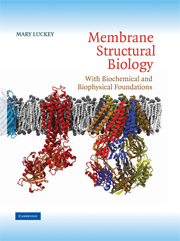Book contents
- Frontmatter
- Contents
- Preface
- 1 Introduction
- 2 The Diversity of Membrane Lipids
- 3 Tools for Studying Membrane Components: Detergents and Model Systems
- 4 Proteins in or at the Bilayer
- 5 Bundles and Barrels
- 6 Functions and Families
- 7 Protein Folding and Biogenesis
- 8 Diffraction and Simulation
- 9 Membrane Enzymes and Transducers
- 10 Transporters and Channels
- 11 Membrane Protein Assemblies
- 12 Themes and Future Directions
- Appendix I Abbreviations
- Appendix II Single-Letter Codes for Amino Acids
- Index
- References
9 - Membrane Enzymes and Transducers
- Frontmatter
- Contents
- Preface
- 1 Introduction
- 2 The Diversity of Membrane Lipids
- 3 Tools for Studying Membrane Components: Detergents and Model Systems
- 4 Proteins in or at the Bilayer
- 5 Bundles and Barrels
- 6 Functions and Families
- 7 Protein Folding and Biogenesis
- 8 Diffraction and Simulation
- 9 Membrane Enzymes and Transducers
- 10 Transporters and Channels
- 11 Membrane Protein Assemblies
- 12 Themes and Future Directions
- Appendix I Abbreviations
- Appendix II Single-Letter Codes for Amino Acids
- Index
- References
Summary
An understanding of their lipid environment, structural constraints and predictions, types of functions, and biogenesis lays the foundation for a survey of membrane protein structures. The remaining chapters showcase a gallery of high-resolution structures selected to be representative of the different well-characterized membrane proteins. The fact that the structures of the vast majority of the proteins predicted to be transmembrane (see “Predicting TM Segments” in Chapter 6) are unknown means these first-obtained structures will not likely portray all types of integral membrane proteins. The class of β-barrel membrane proteins is overrepresented in the structure database, with over half of the approximately 100 unique structures of integral membrane proteins solved as of 2005. They undoubtedly have less structural variation than the class of helical bundle proteins. The progress of determining the structures of helical membrane proteins has increased tremendously with 38 new structures in the last 5 years (Figure 9.1). Even more variety can be expected as new structures are obtained for helical bundles and for membrane proteins of mixed secondary structures.
The availability of structures has provided great insight into how membrane proteins function, igniting much interest and fresh excitement in the field. Often these structures are representative of many others in their families; occasionally they seem unique. This chapter looks at examples of membrane enzymes and transducers (including receptors) that are not part of extensive macromolecular machines; therefore, their structures tell much about how they carry out their functions.
- Type
- Chapter
- Information
- Membrane Structural BiologyWith Biochemical and Biophysical Foundations, pp. 213 - 240Publisher: Cambridge University PressPrint publication year: 2008



